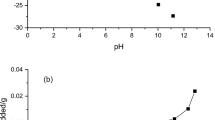Abstract
The binding forms of iron and trace elements (Ni, Co, As) in overburden dump sediments of the Rheinland lignite mining district in Germany were investigated by means of a newly developed sequential extraction procedure in columns (see part 1: Development and description of a new method). The extraction tests aimed to prove the long-term immobilization of iron and heavy metals due to the addition of crushed limestone to the sediment in an effort to reduce the effects of pyrite oxidation reactions on the groundwater quality in lignite overburden dumps.
Because of pyrite oxidation reactions the groundwater in the lignite overburden dumps will contain high concentrations of iron, heavy metals and sulfate at low pH values after the recovery of the groundwater level without taking measures against the acidification. In order to neutralize the acid and to limit the iron, sulfate and heavy metal mobility, crushed limestone is added to the sediment. The investigations aimed to determine the differences between the iron and trace metal binding forms in sediment samples with and without the addition of alkaline substances. The experimental set-up described in part 1 could ensure anaerobic conditions as in the dumps and enabled the determination even of very small amounts of freshly precipitated mineral phases, which was necessary to identify the metal immobilizing processes under realistic conditions.
In investigating the untreated overburden material, iron and heavy metals were mainly extracted from the water-soluble and exchangeable fraction, which means that they are highly mobile and will dissolve in the groundwater in high concentrations. The addition of crushed limestone causes the precipitation of iron carbonate and iron hydroxide mineral phases and the coprecipitation of the trace elements. Under the hydrochemical conditions that are present in the overburden dumps after the limestone addition, these phases are stable and act as an effective and long-term iron and trace element sink.




Similar content being viewed by others
References
Abraham M (1994) Untersuchungen zur sedimentologischen Entwicklung der fluviatilen Deckschichten (Miozän/Pliozän) der Rheinischen Braunkohle.Thesis, University of Bonn, Germany, 229 pp
Cremer N (2002) Schwermetalle im Grundwasser Nordrhein-Westfalens unter besonderer Berücksichtigung des Nickels in tieferen Grundwasserleitern der Niederrheinischen Bucht. Besondere Mitt Dtsch Gewässerkundl Jahrb 60:178
Cremer N, Obermann P, Wisotzky F (2003) Mobilization of nickel, cobalt and arsenic in a multi-aquifer formation of the Lower Rhine valley: identification and modeling of the processes controlling metal mobility. In: Schulz HD, Hadeler A (eds) Geochemical processes in soil and groundwater. Wiley-VCH (in press)
Kringel R (1998) Untersuchungen zur Verminderung von Auswirkungen der Pyritoxidation in Abraumsedimenten des Rheinischen Braunkohlenreviers auf die Chemie des Grundwassers. Thesis, Ruhr-University Bochum, Germany, 176 pp
Obermann P, Wisotzky F (1998) Auswirkungen der Pyritoxidation im Bereich des Braunkohlentagebaus Garzweiler auf die Qualität des Kippengrundwassers—Möglichkeiten und Maßnahmen der Qualitätsverbesserung. Dtsch Gewässerkundl Mitt 42(6):234–240
Parkhurst DL (1995) PHREEQC—a computer program for speciation, reaction-path, advective transport, and inverse geochemical calculations. US Geol Surv Water Resour Invest Rep 95-4227, Lakewood, Colorado, USA, 143 pp
Schultze M, Friese K, Frömmichen R, Geller W, Klapper H, Wendt-Potthoff K (1999) Tagebau-Restseen—Schon bei der Entstehung ein Sanierungsfall. GAIA 8(1):32–43
Van Berk W, Wisotzky F (1995) Sulfide oxidation in brown coal overburden and chemical modelling of reactions in aquifers influenced by sulfide oxidation. Environ Geol 26:192–196
Wisotzky F (1994) Untersuchungen zur Pyritoxidation in Sedimenten des Rheinischen Braunkohlenreviers und deren Auswirkungen auf die Chemie des Grundwassers. Besondere Mitt Dtsch Gewässerkundl Jahrb 58:153
Wisotzky F (1998a) Chemical reactions in aquifers influenced by sulfide oxidation and in sulfide oxidation zones. In: Geller W, Klapper H, Salomons W (eds) Acidic mining lakes. Springer, Berlin Heidelberg New York, pp 223–236
Wisotzky F (1998b) Assessment of the extent of sulfate reduction in lignite mining dumps using thermodynamic equilibrium models. Water Air Soil Pollut 108:285–296
Wisotzky F (2000) Technikumsversuche zur Bestimmung der zukünftigen Grundwasserqualität in Braunkohlenabraumkippen mit und ohne Zusatz von alkalisch wirkenden Zuschlagstoffen. In: Umweltforschungszentrum Leipzig-Halle (ed) UFZ-Bericht no. 6/2000. Geochemische und mikrobiologische Vorgänge in Sedimenten und an der Sediment-Wasser-Grenzschicht in Restseen von Bergbaufolgelandschaften, Magdeburg, pp 37–41
Wisotzky F (2001) Prevention of acidic groundwater in lignite overburden dumps by the addition of alkaline substances: pilot-scale field experiments. Mine Water Environ 20:122–128
Wisotzky F (2003) Saure Bergbauwässer (Acid mine drainage) und deren Qualitätsverbesserung durch Zugabe von alkalisch wirkenden Zuschlagstoffen zum Abraum—Untersuchungen im Rheinischen Braunkohlenrevier. Besondere Mitt Dtsch Gewässerkundl Jahrb 61:167
Wisotzky F, Cremer N (2003) Sequential extraction procedure in columns—part 1: development and description of a new method. Environ Geol (in press)
Wisotzky F, Kringel R (1998) Möglichkeiten der Sanierung saurer Grundwässer durch induzierte pH-pe-Veränderungen in Braunkohlenabraumkippen. In: Dresdner Grundwasserforschungszentrum (ed) Proc 6 Dresdner Grundwasserforschungstage 1998, Dresden, pp 111–121
Acknowledgements
The results presented were obtained in two comprehensive projects funded by RWE Rheinbraun AG (Cologne), Niederrheinische Versorgung und Verkehr AG (Mönchengladbach), Niederrheinwerke Viersen AG (Viersen) and the Environmental Protection Agency/NRW (LUA/NRW, Essen).
Author information
Authors and Affiliations
Corresponding author
Rights and permissions
About this article
Cite this article
Wisotzky, F., Cremer, N. Sequential extraction procedure in columns—part 2: application of a new method. Env Geol 44, 805–810 (2003). https://doi.org/10.1007/s00254-003-0845-7
Received:
Accepted:
Published:
Issue Date:
DOI: https://doi.org/10.1007/s00254-003-0845-7




